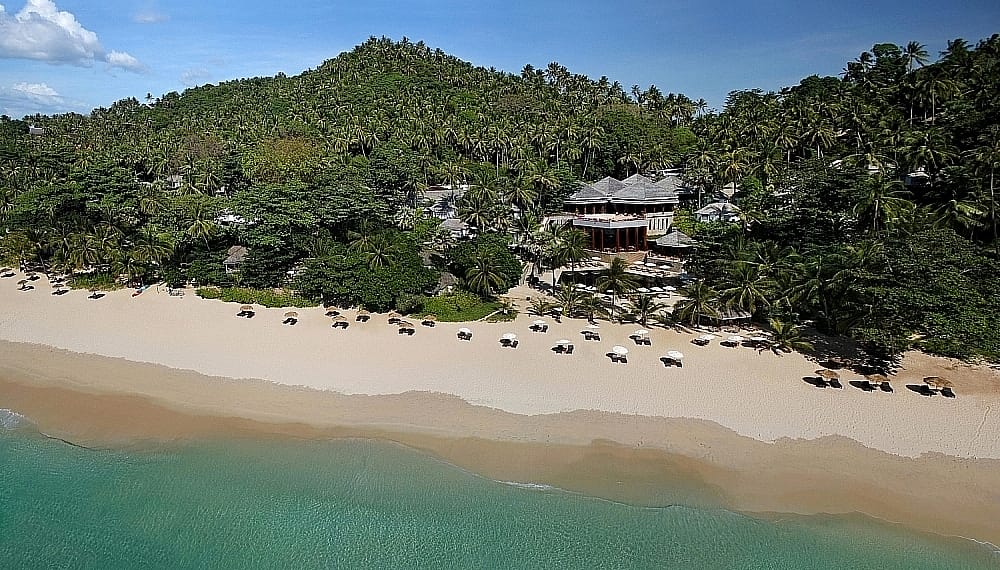La view en rose
Just north of Surin Beach, Phuket’s quieter and more charming alternative to Patong, is a narrow spit of land that juts out into the Andaman Sea. Land meets water here at a sheer angle, creating a layered thicket of picture-perfect coconut palms and tropical plants that slope down to meet possibly the most beautiful beach in all of Phuket, Pansea Bay. Just 400 metres long, the beach faces due west, stunning in the strong light of day or the soft glow of dusk. It also ensures privacy, separated from Surin Beach by a rocky outcrop, with access gained by the resort that dominates Pansea: The Surin, Phuket.

Built in 1982 as The Pansea, the resort was one of the first luxury resorts to be developed in Phuket. Rechristened The Chedi in 1994, the property was damaged during the 2004 Boxing Day tsunami, leading up to a complete refurbishment under its new name in 2012. One man has shepherded the resort through its various incarnations: Edward Tuttle. Synonymous with the highest level of prestige resorts and residences, Tuttle’s original vision for The Pansea and The Chedi was tropical splendour – thatched roofs, dark wood, warm shades of ochre. For the Surin, however, he went in a different direction.
The resort’s phalanx of cottages – all 103 of them – remain perched in their original footprints on the hill slope, connected by a labyrinth of walkways and stairs. Tumbling down in layers and levels, from the The Surin Spa right at the peak of the hill to the Beach Suites down by the sand, Tuttle’s new design in collaboration with designer Jon Varapot Somton is more occidental than oriental. The fresh white walls, grey panels, slate roofs and cool, ashy marble floors could seem more at home at Martha’s Vineyard in New England. The style is simple and utilitarian, almost Shaker-esque, which could fade into being too austere were it not for deft touches of local flavour – silk accoutrements in muted earthy colours that go in harmony with discrete artwork. The Surin does not feel like a stereotypical Thai resort; instead, it feels like a curious and elegant blend of styles comfortable in its mixed heritage.
In the public spaces, the original striking layout was retained and given a new glow – a restrained reception area opens out to a glorious elevated view of the swimming pool and the beautiful Andaman sea just beyond. Height here is used to its full advantage, exaggerated by double storey timber beams that gives the main building a lofty, airy feel that utilises sea breeze to perfection. Nestled within its granite walls is the Lomtalay Restaurant, Sunset Café and The Library, where a curious geometric shape pervades: furnishings, fittings and beams are hexagonal, scaling upwards to a matrix of hexagons that demarcate larger spaces and culminating in the dramatic, jet black hexagon of the swimming pool.
The geometry then fans out from main building – the unbroken paths that connect the cottages are all 45 degree and right angles, ascending and descending in a three dimensional puzzle that makes it a pleasure to explore. Investigating the paths might take you to a small quiet veranda where the tumble of cottages stacked on the cliff appear in a dramatic angle. It might take you up to The Surin Spa, where traditional Thai massage treatment is a balm for sore limbs and the view down the hill is spectacular. It might lead to the tennis courts or the gym, but all paths, in the end, lead to that beautiful beach. With the relaxed Beach Bar at one end, the casual Beach Restaurant at the other and dozens of welcoming beach beds in between, it is easy to see why many consider Pansea Beach to be Phuket’s greatest. It might seem to a cliché to sip champagne while admiring a perfect sunset on these white sands, yet somehow The Surin makes even the most clichéd of actions quite special.











